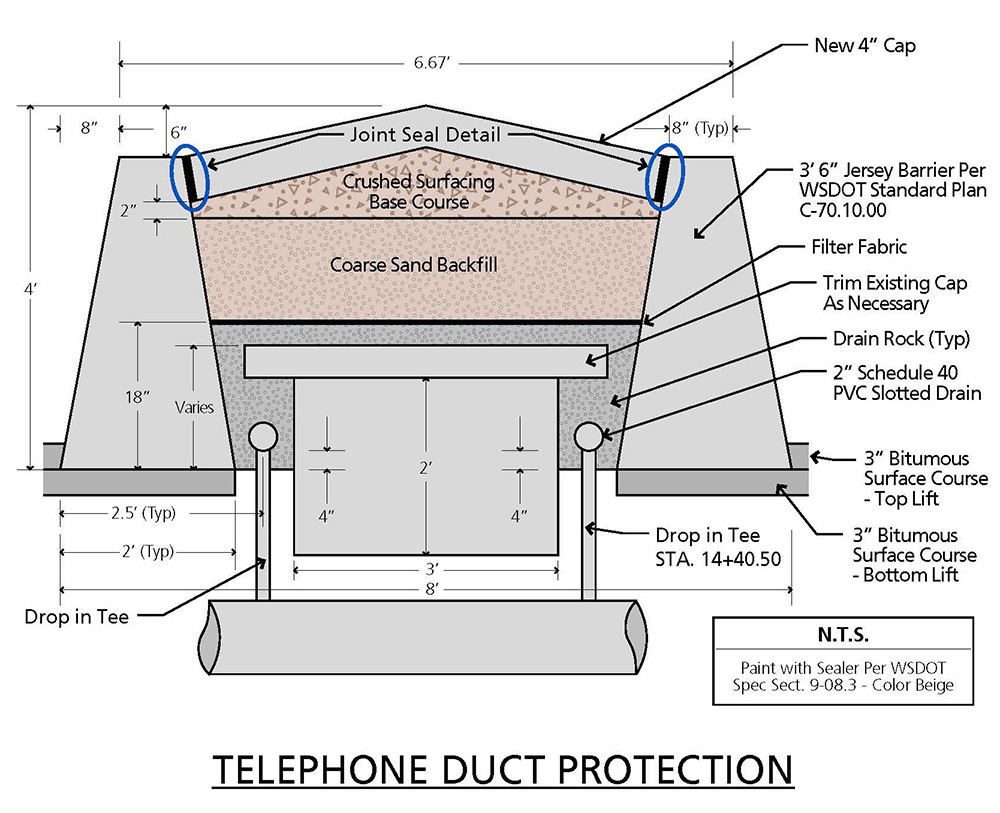Reid Middleton designed the full $8 million reconstruction of Runway 16L-34R, a 3,000-foot general aviation runway, connecting taxiways, and lowering of a perimeter road at Snohomish County Airport (Paine Field) in Everett, Wash. Construction began on May 20, 2013, and was to be completed in 46 calendar days. Ambitious, but feasible, until the day a fiber optic cable was discovered just beneath the surface of the perimeter road.
Change of Plans
Anytime you work on an airport runway, you can expect accelerated construction schedules and tight turnaround expectations. On a busy general aviation runway, whose users include the world’s leading aerospace company, expediency is critical. You lay out an aggressive timeline based on sound engineering design and construction experience. When the unexpected comes along, you have to come up with a new plan. That’s what the project needed, and fast.
We were aware that a fiber optic line ran under the perimeter road, and the utility companies had been contacted to mark utilities in the portion of the perimeter road that was to be reconstructed. The utility that owned the fiber optic line came out to provide depth information. They checked the depth of the fiber optic cables in the manhole, then potholed three additional depth verification holes, none of which encountered the fiber optic line. Based on the information, it was assumed that the line was at least 13 feet deep. As it turned out, the line rose shortly after exiting the manholes, and was right under the elevation of the existing perimeter road, the road that needed to be lowered as a part of the project.
Teamwork toward a New Solution
We knew the project schedule could not accommodate the time required to lower the cable to the proper depth. We considered moving the perimeter road east or west to avoid the cable, but with another road being too close on the east and insufficient room between the perimeter road and Runway 16L-34R safety area on the west, this was not possible.
Brainstorming sessions with Paine Field Airport staff led to the exploration of an option to leave the cable in a median in the center of the perimeter road and to provide a concrete barrier structure as protection for the cable. A cast-in-place structure was considered but proved too expensive. The use of precast Jersey barriers was then suggested. This proved to be less expensive and feasible. We prepared rough sketches of a Jersey barrier solution within an hour and reviewed it with airport staff and the contractor.

Reid Middleton prepared a formal drawing of the proposed median structure in a late night effort, allowing airport staff to review and approve the drawing. The construction of the median structure was set in motion. The use of the median concept did require significant redesign of the perimeter road profile, alignment, cross sections, and storm drainage.

The alignment and profile had to be adjusted to match the grades and alignment of the cable, which also resulted in lowering the road and moving it closer to Runway 16L-34R. This, in turn, meant the proposed graded slopes from the perimeter road to Runway 16L-34R safety area were too steep, and a retaining wall had to be constructed to accommodate these steeper slopes. The changes in the perimeter road alignment and profile, design of a retaining wall including security measures on top of the wall, and changes in the storm drainage system required several days of long hours of redesign by the Reid Middleton staff and coordination with the airport staff and contractor to meet the required schedule.

The development of the median structure as a solution to the fiber optic cable location represents an example of the owner, engineer, and contractor working cooperatively to come up with an excellent solution to an unexpected situation arising during construction.
About Our Author: Reinhart Jung, PE, is a Principal Engineer in Reid Middleton’s Airport Group. His responsibilities include overseeing the design and construction engineering of airport improvement projects. Reinhart has a record of working on Paine Field projects since the early 1970s. He has enjoyed working with Bruce Goetz and his Operations team, as well as Bill Dolan, Dave Waggoner and all the friendly staff at Paine on many projects over the intervening years.

